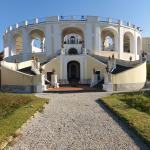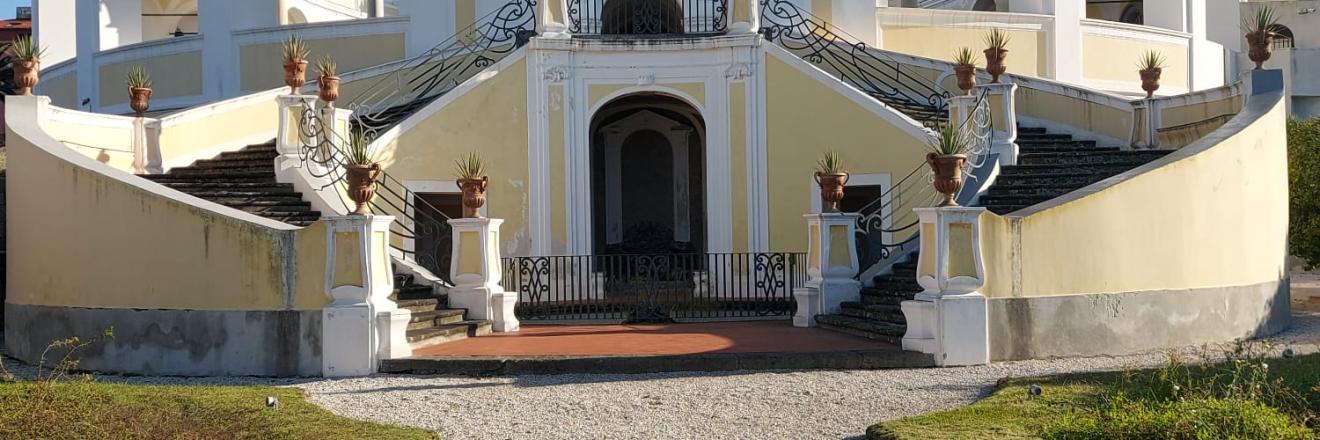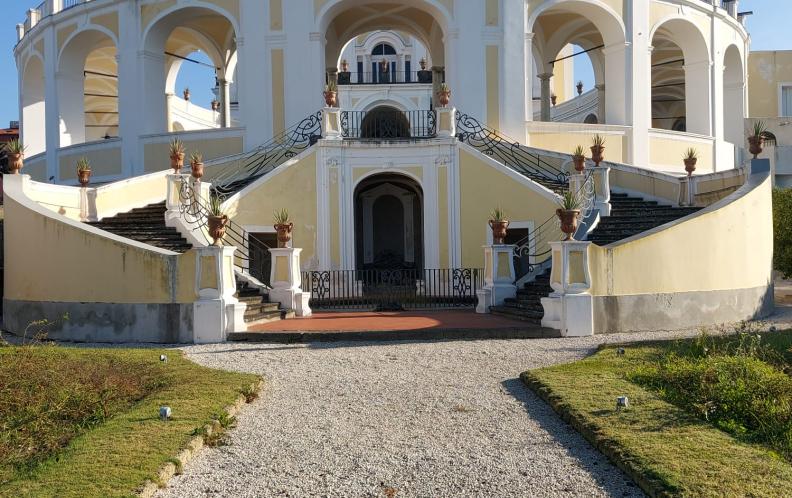Established in one of the happiest and most evocative locations, downstream of the Bourbon road of Calabrie, not far from the Royal Palace of Portici and contiguous to Villa Favorita, Villa Campolieto was built at the behest of Prince Luzio De Sangro, Duke of Casacalenda, who in 1755, entrusted the design and execution of the work to Mario Gioffredo. Forced to abandon the work around 1760 he was replaced by Luigi Vanvitelli who, from 1763 to 1773 (the year of his death) directed the work, which was completed in 1775 by his son Carlo. Villa Campolieto, acquired in 1977 by the Ente per le Ville Vesuviane, now a Foundation, after 6 years of restoration was restored to its primitive splendor and returned to public use. The building is set on a square plan, articulating the four blocks of a central gallery in the shape of a Greek cross, and is spread over five levels. The rear façade of the Villa opens with an elliptical Tuscan-columned portico forming a covered belvedere and concludes with a magnificent sea view with a pool and an elliptical-shaped staircase that joins the building to the garden below. To the left is the imposing stables designed by Gioffredo, with cross vaults and piperno pillars. Vanvitelli ?distorting Gioffredo's original design? completely redesigned the Villa's staircase, creating a central ramp and two lateral ones on the model pioneered in Caserta, enriching it with a mascaron and a grotesque located on the inner side of the entrance arch and by six niches that mark the ascent to the main floor containing statues with mythological subjects, the vestibule then, is presented with a domed covered atrium flanked by two apsidal niches. Its function was to welcome and direct guests to the different rooms of the apartment. From the room called the ?Cannocchiale? for its characteristic conformation, one enters the private rooms of the family, arriving then in the dining room, certainly one of the most striking rooms of the villa, conceived by Gioffredo in a square shape with a barrel ceiling, it was distorted by Vanvitelli who, gathering the wishes of the master of the house, made it circular with a technique known as ?Incannucciata?, which consists of a wooden ribbing, overlaid with bamboo canes, plastered and then frescoed. The fresco, which decorates the entire room, the work of Fischetti and Magrì, reproduces the supporting structure depicting a gazebo covered with a vine grown in the prince's funds and where the family loved to laze with guests on fine summer days. With our backs to the window, looking at the fresco from right to left, we first encounter a group of people playing cards including De Sangro, followed in the background by the islands of the gulf, and past the door we can see one of the few self-portraits on a fresco of Vanvitelli scanning the sky with a monocle. The service doors blend in with the fresco, part of which has been lost along with one of the four seasons depicted in the corners of the room. The hall ?of the Mirrors?, located in this wing of the palace, was a women's study, as can be deduced from the muted colors, in which people engaged in conversation before entering the ballroom. Although the construction of the 18th-century Vesuvian villas was designed in such a way as to privilege external enjoyment over internal use, great importance was given to the Salone delle Feste. In what remains of the barrel-ceiling fresco, mythological figures with festoons, cupids, and supporting architecture can be glimpsed. The frescoes on the walls depict the myth of Hercules with eight medallions depicting his life, two niches with statues of Hercules and Cupid, while the lunettes above the doors depict Abundance and Wisdom. Stepping out onto the terrace, one can admire one of the most striking and panoramic views of the Gulf of Naples, from Posillipo to Ischia to Capri and the Sorrento Peninsula. On either side of the balcony two staircases branch off leading to the uncovered walkway of the arcade, heading to the right one glimpses four sentry boxes that bordered a fishpond and served as shelter from the sun while fishing. In the background, the view opens toward the forest of the Palace of Portici and the Herculaneum archaeological area. Facing the center of the promenade, we admire the architecture designed by the elliptical staircase that leads to the fountain and the Palm Grove. Continuing the promenade and turning our backs to the sea, we admire Vesuvius dominating the landscape with its grandeur, on the same perspective Villa Ruggiero, on the right Villa Favorita
Map
Villa Campolieto
Corso Resina 283, Ercolano
TUE
WED
THU
FRI
since 10:00
to 18:00
SAB
DOM
since 10:00
to 13:00
Price:
Single entry
€6.50
da €-0.01
Gallery
Additional information
Reservations:
prenotazioni@villevesuviane.netGroup entrance fee with in-house guide ? 7.00 and reservation required
Free for the disabled and children under 6 years old
Did you like it? Leave a review
Your opinion is important! It will be visible after approval by the editorial staff.
To post a comment you must be an authenticated user.






